Haddad is an Arabic surname meaning blacksmith, commonly used in the Levant and Algeria.
Asian Latin Americans are Latin Americans of Asian descent. Asian immigrants to Latin America have largely been from East Asia or West Asia. Historically, Asians in Latin America have a centuries-long history in the region, starting with Filipinos in the 16th century. The peak of Asian immigration occurred in the 19th and 20th centuries. There are currently more than four million Asian Latin Americans, nearly 1% of Latin America's population. Chinese, Japanese, and Lebanese are the largest Asian ancestries; other major ethnic groups include Filipinos, Syrians, Indians, and Koreans. Brazil is home to the largest population of East Asian descent, estimated at 2.08 million. The country is also home to a large percentage of West Asian descendants. With as much as 5% of their population having some degree of Chinese ancestry, Peru and Mexico have the highest ratio of any country for East Asian descent. Though the most recent official census, which relied on self-identification, gave a much lower percentage.
Arab Canadians come from all of the countries of the Arab world. According to the 2021 Census, there were 690,000 Canadians, or 1.9%, who claimed Arab ancestry. According to the 2011 census there were 380,620 Canadians who claimed full or partial ancestry from an Arabic-speaking country. The large majority of the Canadians of Arab origin population live in either Ontario or Quebec.

Arab Brazilians are Brazilian citizens of Arab ethnic, cultural, linguistic heritage and identity. The majority of Arab Brazilians trace their origin to the Levantine region of the Arab World, known in Arabic as Bilad al-Sham, primarily from Lebanon and Syria, as well as Palestine. Arab Brazilians are Christians in the great majority. The first Syrians and Lebanese arrived in São Paulo around 1880. It is not known exactly when, although the Syrians and Lebanese say that in 1885 there was a small core of peddlers working in the market square. By 1920, the census listed 50,246 Syrians and Lebanese in Brazil, 38.4% (2/5) of these in the state of São Paulo. The 1940 census enumerated 48,614 Syrians, Lebanese and other related groups with a decrease of approximately 1647 people. As immigration almost ceased after 1929 and the colony aged, it is surprising that the decline was not even greater. The trend of the period between 1920 and 1940 was the continuous concentration of Syrians and Lebanese in São Paulo. Almost half (49.3%) of Syrians and Lebanese residents in Brazil lived in São Paulo.
Khoury, also transliterated as Khouri, is a Levantine surname that is found among Christians in the Middle East. The term Khoury means "priest" in Levantine Arabic. It derives from the Latin word curia, or may come from the French curé meaning parish Priest, from Medieval Latin curatus "one responsible for the care ," from Latin curatus, past participle of curare "to take care of".

British Arabs are British citizens of Arab descent. They share a common Arab ethnicity, culture, language and identity from different Arab countries. Arabs also come from non-Arab countries as ethnic minorities.
Arab Chileans are Chileans from predominantly Arab ancestry. People from the Arab world arrived in Chile as early as the mid-19th century. Historically, the Arabs of Chile were called Turks, Moors, Syrians, Lebanese, or Palestinians.
Arabs in France are those parts of the Arab diaspora who have immigrated to France, as well as their descendants. Subgroups include Algerians in France, Moroccans in France, Mauritanians in France, Tunisians in France and Refugees of the Syrian Civil War. This French subgroup of Arabs in Europe are concentrated in the Maghrebi communities of Paris.
Arab Australians refers to Australian citizens or residents with ancestry from the Middle East and North Africa, regardless of their ethnic origins. Many are not ethnically Arab but numerous groups who include Arabs, Kurds, Copts, Assyrians, Berbers and others. The majority are Christian by faith with minorities being Muslim, Druze, Yazidi and other faiths.

Lebanese Mexicans refers to Mexican citizens of Lebanese origin.

Arab Germans, also referred to as German Arabs or Arabic Germans, are ethnic Arabs living in Germany. They form the second-largest predominantly Muslim immigrant group in Germany after the large Turkish German community.
Ayoub is the Arabic name of the biblical figure Job.
Arabs in Austria are Austrians of Arab ethnic, particularly Lebanon, Syria, Palestinian, Iraq, Jordan and also small groups from Egypt, Algeria, Tunisia, Morocco, Libya, Yemen and Sudan, who emigrated from their native nations and currently reside in Austria. Most Arab Austrians are of Iraqis and Lebanese or Syrian origin, as a result of the fact that they were the first Arabs to arrive in Austria.
Arabs in Denmark are Danish permanent residents of Arab descent, who originate from Arab countries. The largest number of Arabs in the country are Iraqis. The majority hail from Lebanon, Syria, Iraq, Palestine, and Morocco followed by smaller groups from other Arab countries. They mainly live in Copenhagen, Aarhus and Jutland. There were 121,000 Arabs in Denmark as of 2017.
Syrian Uruguayans are Uruguayan citizens of Syrian descent or Syrian-born naturalized Uruguayans.
Arab Uruguayans are residents or citizens of Uruguay of Arab ethnicity, whose ancestry predominantly traces back to any of various waves of immigrants from the Arab world, especially Lebanon and Syria.
Syrian Mexicans are Mexicans of Syrian origin. According to the 2000 census, there were 246 Syrians living in Mexico. In 1890, there were more than 1,000 Syrians residing in the country, but the vast majority emigrated to the United States because of the Syrian civil war.







